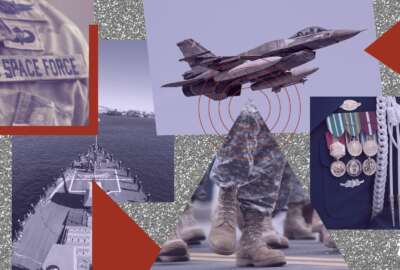
This tiny vendor got a big Air Force contract, and defied the odds
The company is called Ditto. Not a household name in defense contracting. But if just got an indefinite delivery, indefinite quantity contract from the Air Force,...
Best listening experience is on Chrome, Firefox or Safari. Subscribe to Federal Drive’s daily audio interviews on Apple Podcasts or PodcastOne.
The company is called Ditto. Not a household name in defense contracting. But if just got an indefinite delivery, indefinite quantity contract from the Air Force, worth a potential billion dollars. Joining the Federal Drive with Tom Temin with the Air Force requirement it’s hoping to meet, Ditto CEO and co-founder Adam Fish.
Interview transcript:
Tom Temin: Mr. Fish, could to have you on.
Adam Fish: Thank you for having me.
Tom Temin: Tell us what the problem the Air Force came to you with and awarded you this contract for.
Adam Fish: We’re a young company based in California as a technology startup. And the larger aspect to this contract really goes back to the JADC2 efforts, where the DoD, including the Air Force, is really trying to re-imagine their entire network system behind all their military weapons systems. And so that’s at the heart of what Ditto does. Ditto is a software platform that enables devices to connect and share data in real time, even in very austere or degraded environments, which is exactly you know, what the military is operating in.
Tom Temin: So it sounds like the need is to connect, say, centralized systems or even cloud systems with the increasing thing you hear about so much is edge computing, which might be the cube computers, or the self contained data centers, many, many form factors that go with military units, as you say, into those austere environments?
Adam Fish: Yes, absolutely. And this has become an ever more important aspect as the DoD has kind of shifted its focus towards near peer competitors, where not only do you have to worry about the austere conditions that the military is operating in. But you also have to worry about having your communication systems broken, or jammed. And that’s something that is a real possibility when thinking about near peer competitors. And so as a result, they really want to make sure that their networks are resilient to those problems. And the way to do this is actually to go back to kind of like the origins of the internet, where it was very much a peer to peer system, you know, back ARPANET, Mil Net, those early, early versions of even the commercial internet, were all based in a peer to peer system, where devices can operate semi independently. Unfortunately, in the modern era, cloud computing has kind of inverted that, where things have become centralized, where you have a central server, and if that breaks, devices can’t talk to each other. And that’s not going to work for the military in these environments. And so they want to get back to a system that’s resilient and can work, whether it’s at the edge or in the cloud, in a more peer to peer mesh manner. And our software platform that is something that helps enable applications to do that.
Tom Temin: Yeah, that’s always the tension over the history of computing really is the central server and the small, thin clients versus that peer to peer where the computing is distributed. That’s the central issue here?
Adam Fish: Exactly. And it’s funny how, when you look back over the course of computing history, this has kind of come and gone in waves, where it started out as a very centralized system where mainframe computers, you know, people would log in, and it actually it was kind of like a cloud computer where you would rent time at the mainframe. But then personal computers led for it to become distributed again. And then cloud computing kind of went back to the mainframe model. What we’re seeing, though, and this is in the military, but even outside of the military, is that with mobile devices, edge type computing systems, you now have the processing power to do things at the edge versus having to go back to that central system. So it’s really a confluence of several factors is that the computing system operating at the edge can actually do more today. And as a result, the military wants to take advantage of that.
Tom Temin: We were speaking with Adam Fish, He’s CEO and co-founder of Ditto, which just got a very large Air Force contract. And just briefly, what is the technological means by which you can make sure that data is synchronized from central locations through an austere or interrupted environment to the edge computers, when in fact, the connections may not be there?
Adam Fish: Great question. The core premise behind Ditto is that today, any type of application, if you go into your mobile phone, and you open up whatever your favorite app is, that application is going to talk to a central computer to get all the data that it needs. And so even if you send a message and you say, hey, I want to text message a friend, it’s going to first go through a central server to go to that other person’s device. And that central system is a point of failure. That’s how we think about it, like from a software architecture perspective. And having points of failure in your system is risky when lives are on the line. And so that is what the military is trying to solve is how can we take the points of failure between our data communication links and remove them and create multiple ways that data can move. And so the way that that works is that devices need to be able to create arbitrary connections with each other, such as two mobile devices, if you were standing next to each other, why can’t that device just transmit the data to the other device using something like Wi-Fi, or Bluetooth, a local radio versus having to use the cellular connection to go back to a server to send the data. And so that’s the problem that the military has, in a big way, because they have so many different weapons systems with different radios. And so they have the capability to transmit data in different directions. But right now, those things don’t really talk to each other. And so the JADC2 efforts broadly across the DoD, ABMS for the Air Force, which is what we’re involved with is a way to rethink how all those weapons systems talk to each other. So they have resilient paths to transmitting data so that it doesn’t get blocked.
Tom Temin: And you can always fly a carrier pigeon holding a thumb drive, I guess, in the last analysis, if you have to.
Adam Fish: Exactly. It’s a real thing. I think, unfortunately, in a lot of situations, movement of data could actually be involved in a more physical manner where people are carrying thumb drives, hard drives, that does happen. And it’s something to think about is like that might be the most relevant or safe path to move data in certain situations. But at the end of the day, the software systems need to be able to handle data moving in multiple different paths. And that’s a very different approach to building software than having one that always talks to a central server.
Tom Temin: And this is an IDIQ contract, which generally is for goods. So how does that work? Are they buying you copy by copy, depending on the unit that needs it? That is to say, are you offering a cloud based service, apparently not, sounds like something that is replicated locally, as traditional software licenses.
Adam Fish: Yeah, it’s actually a little bit of both, because at the end of the day, there is a need for cloud systems, it’s not that everything can work on the edge, no one would want that there are benefits of both where you need to have the ability for data capture at edge locations and have those systems to be able to talk to each other independently. But then that data needs to get back to big powerful central systems. So you can do analysis on them. And that really would be the ideal situation, especially for ISR type missions, where you might be out flying missions capturing tons of information at the edge. And there might be some processing that happens there in real time. But then there needs to be the ability to move back that data to big systems to analyze it, and then push those insights back out. And so that whole loop of data capture to data analysis, and then action off of that, that, you know, it’s commonly thought of as like the chain that the DoD is trying to shorten, so that they can act on that as quickly as possible. And then that really captures the larger JADC2 effort. And so our software has applicability across all of that. We have edge software, that would be licensed, but there is also a cloud component for the analysis part as well.
Tom Temin: So the IDIQ aspect, then is that different pieces of the Air Force have the opportunity to take advantage of the contract?
Adam Fish: Correct. Yeah. And it could be used for different purposes, different use cases, but broadly covering any of our software. And so there is definitely a variety of use cases that we see. For example, one would be involved with the Agile Combat Employment effort, ACE, where there is a lot of need to be able to quickly create like a remote base, perhaps in a remote area where everything has to be flown there and be carried in. And so you have to basically just like create everything very quickly. And so as a result, you need software that’s very adaptable to that situation. And so that’s where our edge software could really help in terms of the data capture that that remote location, but then it could be transferred back to a cloud back end for analysis.
Tom Temin: Not many companies with 30 people get billion dollar potential IDIQs through the Federal Acquisition Regulations, or the DFAR. A lot of them are getting OTA deals but the sounds like a DFAR-based deal. How did you even know about the Air Force?
Adam Fish: Yeah, it’s actually a bit surreal. Speaking personally, when we got started, there is definitely a view in Silicon Valley of like, hey, is it a good idea to work with the government, things can take a long time working with the government. It’s a little obscure, and there was part of us, our team that was a little skeptical of it just because of that history, but this was something that was really exciting for us, and we felt like it was absolutely necessary that we needed to find a way into the military, given the nature of our product and how much impact it can have. And so we actually got started with the Air Force in a program called AFWERX. And so it’s a Small Business Innovation program that is designed to connect commercial companies like ditto and bring them into the government. And so that was a great pathway for us into and you know, it’s continued to snowball to where we are today. But it’s definitely been very exciting ride.
Tom Temin: So in many ways, the government was one of your seed contracts to really get revenue into the company.
Adam Fish: Correct. Yeah. And that that took a concerted effort where we wanted to make that a priority. And that’s something that I’m very proud of, because I think the impact the potential here is, is really significant. And I think, you know, more broadly, more technology companies need to be paying attention. We have big challenges ahead of us as a country in thinking about Russia and China and others. And technology is going to be a key player in that. And so right now, the best technology is not being built inside the government. It’s being built in commercial companies. And I’m excited that Ditto is able to take our technology and have an impact.
Tom Temin: Adam Fish as CEO and co-founder of Ditto, thanks so much for joining me.
Adam Fish: Thank you.
Copyright © 2025 Federal News Network. All rights reserved. This website is not intended for users located within the European Economic Area.
Tom Temin is host of the Federal Drive and has been providing insight on federal technology and management issues for more than 30 years.
Follow @tteminWFED
Related Stories





